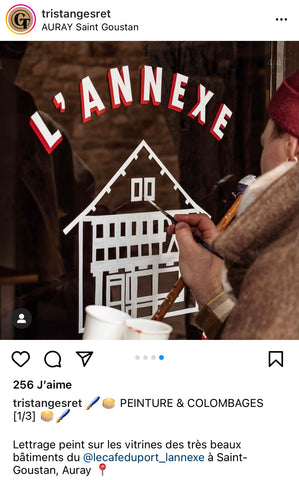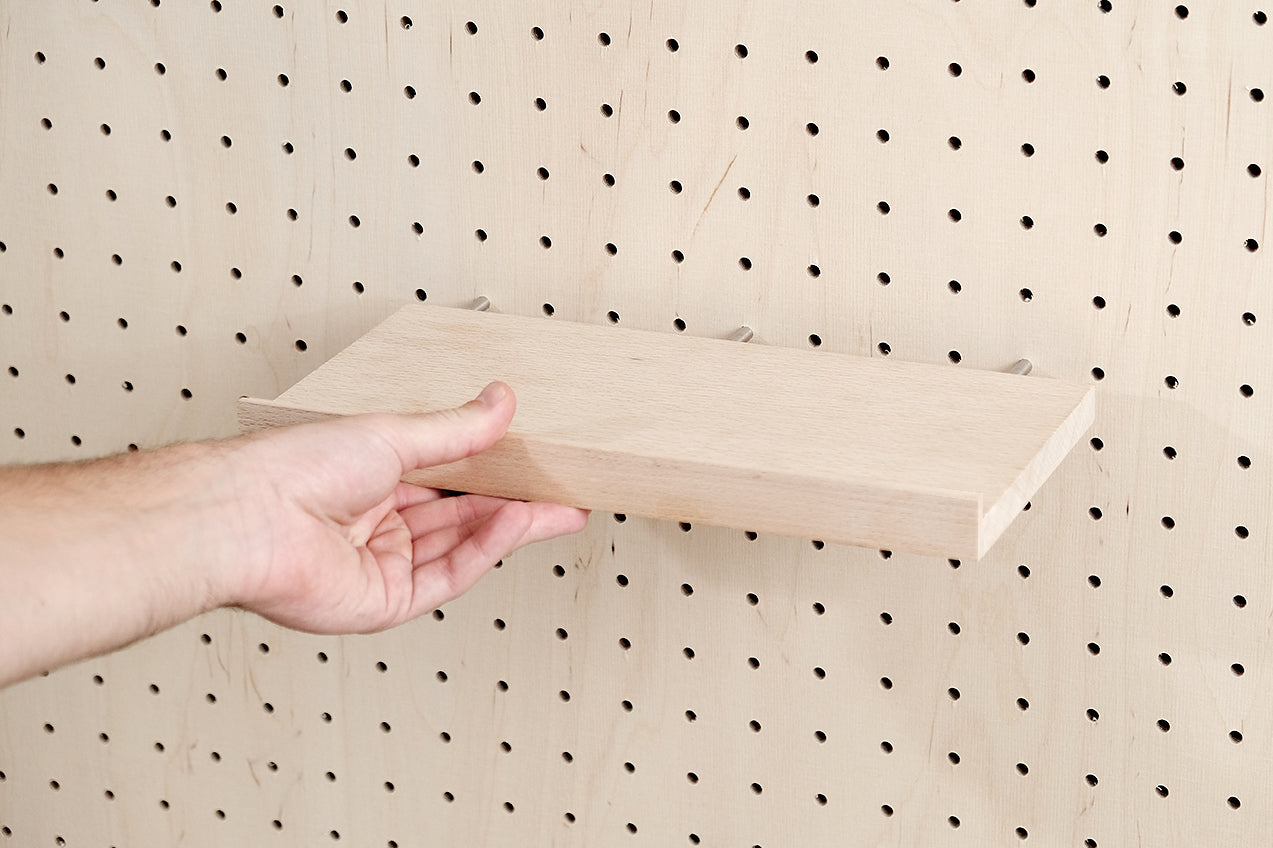Aire went to meet Tristan Gesret . He is a craftsman who paints letters . In addition to doing exceptional work, he has the merit of learning this trade on his own. We are happy to highlight a talented French craftsman.

Can you introduce yourself and your work as a sign painter?
My name is Tristan Gesret and I'm 32 years old. I'm Breton and I live near Vannes. I've been a letter painter for the past three years.
I have an atypical background. I wasn't at all predestined for a career in the arts. I never knew what to do. So I listened to my parents. I got a science baccalaureate. And I went into medicine because there were a lot of opportunities.

Afterwards, I worked in real estate. I even got a degree in real estate law. Afterwards, I got fed up, so I experimented on my own, such as traveling. Then, four years ago, I discovered letter painting by chance. It was a revelation, and I got into it completely.
Is the profession of letter painter an art or a craft?
I consider myself a craftsman . There is a lot of theoretical learning such as letter sizes, proportions, typography, color combinations... I don't give up during my projects.

I also make signs, so I work a lot with wood .
Where are you with your projects now?
Since I started out on my own 3 years ago, it's grown. Quite quickly. My girlfriend joined the company. She's the one who manages communications. That's why we're productive on social media. We also have a part-time employee who's a graphic designer. It takes the load off our shoulders. Because ultimately, we have a lot of work to do on the computer. There are plenty of things that enhance the job of a sign painter. But, even if we excel, we can't do without the computer. So we use it to make models, inlays, and lots of other things.

At the time, the restaurateur would call the sign painter, and then he would want the word "restaurant" written on the facade. Possibly with a specific color. Then the sign painter would create the lettering directly, with a small sketch.
Nowadays, clients are more demanding . In addition, today, there are requests to be made to APS (Professional Planning Agency), architects of buildings in France, and other people. So, we have to make several computer proposals, several inlays, the exact dimensions, find the right color. As a result, it takes us longer than before.
Today we have a small workshop at home, in an outbuilding. It's very small, so we quickly get overwhelmed in the workshop. But, starting next fall, we're moving to a 200 square meter workshop!

As for the studio projects, we work all over Brittany and the whole of the Grand Ouest region. Our projects are quite varied ; I can paint for restaurants, schools, shops, bars, institutions, or even individuals who have collector vehicles.
What was your biggest challenge as a sign painter?
One of the projects that made me famous was a facade that was 9 meters high and 6 meters wide.
I had just started letter painting, so I wasn't very comfortable with it yet. Then it's impressive to find yourself in front of this big wall. But we succeeded. We made it to the end, and we were happy. We would really like to develop this type of project. Painting on large facades like in Le Havre back in the day. I would really like it to come back into fashion! I'm convinced it will.
Especially in an era where everyone takes pictures of everything , everything goes through the image. It would be great if a company started communicating like that, it would create a huge buzz. But unfortunately it costs more than a billboard.

This is one of my future challenges. I'm ready to travel all over France to persuade a company to do this.
Then we did another cool project. It's the Grain de Sail boat. It's chocolate that's sold in supermarkets. They created the first transatlantic cargo sailboat that fetches cocoa from South America. And they sail back to Brittany to take part in the French market. So, there's an eco-responsible approach thanks to a low carbon footprint.

They asked me to paint the name of the boat. I was swinging on ropes above the water. It was impressive. Plus, it was windy. I had to stabilize myself. I don't think I've ever been so sore after a construction project.

Your favorite tools?
In terms of equipment, it's really very varied. When you're tackling large facades, you have large brushes that are very pleasant. I use sash brushes. I'm really starting to love this brush. Then there are also flat brushes and small spalters.
On the other hand, for small signs where precision work is required, we use sable hair brushes. These are very long and soft natural bristles. You really have to take care of them. They allow you to take a large load of paint to make large , seamless lines. The goal is to make as few strokes as possible.

In my left hand I have a cane and in my right hand I have my brush. My right hand is resting on a cane that I hold with my left hand. It allows me to be stable and it is my left hand that moves the cane in order to have more precise strokes.
How do customers approach you?
They use Instagram a lot, now we can't live without it. Then there's also a lot of word of mouth. As soon as we arrive in a new street, since the work is visible, the shopkeepers spread the word .
What stage does a project begin with?
I ask, “What are your expectations?” I want to understand the style , so I can offer advice. We suggest typography, effects, and colors that are consistent with the desired style.
Now there's the graphic charter, which is present almost everywhere and must be respected. This represents two-thirds of projects. In this case, we adapt the graphic charter to the facade.

And finally, I like projects based on a style as much as those with a graphic charter. Because projects where you have to create a whole universe are very energy-consuming . And in reality, I won't have time to do just that. And then reproducing a graphic charter identically is rather a challenge. In addition, it allows me to work with graphic designers who are really talented.
Concretely, I like a carte blanche from time to time.
How is a project organized?
We're very organized so as not to waste time. We start with an on-site meeting with the client. We have to immerse ourselves in the space. Because it's not just "painting a facade." It has to fit in with the street and the architecture. So we have to understand the client's expectations.

We make small sketches by hand until we understand what the client wants. Then, we provide regular feedback on the project's progress. This allows us to validate each step. We can't arrive with a finished project if it doesn't suit the client.
How does a project end?
My job is great because we generally have the same way of seeing things with clients. It's a different mindset because it's a financial effort on the client's part.

We often come across friendly, open-minded customers. What's impressive is that we sometimes develop friendships with customers . We're coming to the end of the project, so it's usually the final touch . Customers are often delighted, they no longer have any work in progress and are ready to open! It's good vibes.
Are there any difficult aspects of being a sign painter?
Yes, and it's important to emphasize this. I'm in high demand for internships because there are lots of people who want to become foremen or something else. This is a bit of an Instagram problem. Because everything is beautiful, everything is staged. While in reality, there's a lot of prep work, the climate in Brittany is: damp and cold.
Sometimes you have to walk for miles, or even put up scaffolding. You have to stand for hours in front of a facade, making small letters.

It is a work of patience and physicality and where you must not lose your concentration.
I take on as many interns as possible because I have to show the difficulties of the job .
Do you have any fears in your job?
I'm always afraid of not succeeding. I still have a lot to learn. There is no longer any training for sign painters. So I teach myself. That's why I'm never 100% sure of myself. Despite that, it always goes well. But I still have this fear of messing up my stroke . Thanks to my experience, I'm more and more comfortable. Then once I'm there, the fear quickly fades.

When I start painting , I enter into symbiosis with my brush . I am almost in meditation. Time passes very quickly and I clear my mind.
Do you have any Instagram accounts to share?
@siclone_

He's a carpenter who creates surfboards, skateboards, and even cut-outs for restaurants. I work with him regularly. In fact, he's practically my neighbor. We only live 500 meters away as the crow flies. We mostly collaborate for brands.

David is a craftsman who lives in the same town as me. He is a luthier. His talent has earned him several awards. He loves his craft and is truly passionate about it.
Don't hesitate to take a look at our latest article: Houbly and their bio-sourced materials


0 comments